Submitted by WA Contents
New exhibition at V&A Dundee explores our relationship between plastic and nature
United Kingdom Architecture News - Dec 08, 2022 - 10:24 3320 views
A new exhibition at V&A Dundee explores our relationship between plastic and nature and the nature of the plastic material we consume in our daily lives.
The exhibition, titled Plastic: Remaking Our World, has opened at Kengo Kuma-designed V&A Dundee Museum in Scotland and will be on view until 5 February 2023.
The exhibition examines the history and the future of this controversial material - from its early origins when it was intended as a sustainable alternative to natural resources, to its meteoric rise in the twentieth century.
This is the first exhibition V&A Dundee has co-curated with partners, Vitra Design Museum, Germany, MAAT Lisbon and V&A South Kensington.
"Plastic has shaped our daily lives like no other material: from packaging to footwear, from household goods to furniture, from cars to architecture," said V&A Dundee.
"Today the dramatic consequences of the plastic boom have become obvious, and plastic has lost its utopian appeal. Never has it been more important to understand the 150-year history of this contested material, known to be essential yet superfluous, life-saving and life-threatening, seductive yet dangerous," V&A Dundee added.
Laura Young (Less Waste Laura) in the Re-section at Plastic: Remaking Our World
The exhibition is divided into three sections: Synthetica, Petromodernity and Plasticene. Alongside plastic materials and objects, visitors encounter with colourful installations, videos, photographs and video films to better understand the nature of plastic.
The striking title treatment for Plastic: Remaking Our World, designed by Daniel Streat of Visual Fields, provides the first opportunity to stop and think about the nature of the plastic we consume, where it comes from, and where it ends up.
V&A Dundee stated that all the plastic in this colourful installation has been locally sourced and prepared by V&A Dundee and ScrapAntics.
Re-section of Plastic: Remaking Our World
Upon entering the exhibition, visitors are introduced to the relationship between plastic and nature when stepping into KALPA, an immersive large-scale video installation by Asif Khan Studio.
KALPA immersive video installation at Plastic: Remaking Our World
"The reality is that while fossil fuels took some two billion years to form, plastic has caused irreversible damage in a fraction of the time," said V&A Dundee.
Synthetica section of Plastic: Remaking Our World
The first section, titled Synthetica, looks at the emergence of natural plastics, derived from plants and animals. Industrialisation and rising incomes in the late nineteenth century increased demand for natural plastics and kindled interest in new materials leading to an abundance of material experimentation and innovation.
The first fully synthetic plastic, Bakelite, was invented in 1907 by Leo Baekeland. Its insulating and nonconductive properties made it ideal for light switches, wall sockets or radio sets and played a central role in the electrification of everyday life.
Petromodernity section of Plastic: Remaking Our World
The second section is Petromodernity and it shows how the rise of the petrochemical industry from the 1920s onward increased plastic production exponentially.
During the Second World War natural materials such as wool, silk and metals were increasingly scarce. The production of plastics became an integral element of the war effort, including nylon for parachutes and tyres and acrylic for cockpit canopies.
Plasticene section that looks at "the plastic paradox" in Plastic: Remaking Our World
Plasticene is the third section and looks at how the post-war plastics industry searched for new applications for wartime innovations with plastics finding their way into homes in the form of time-saving devices, easy-to-clean gadgets, and safe, colourful children’s toys.
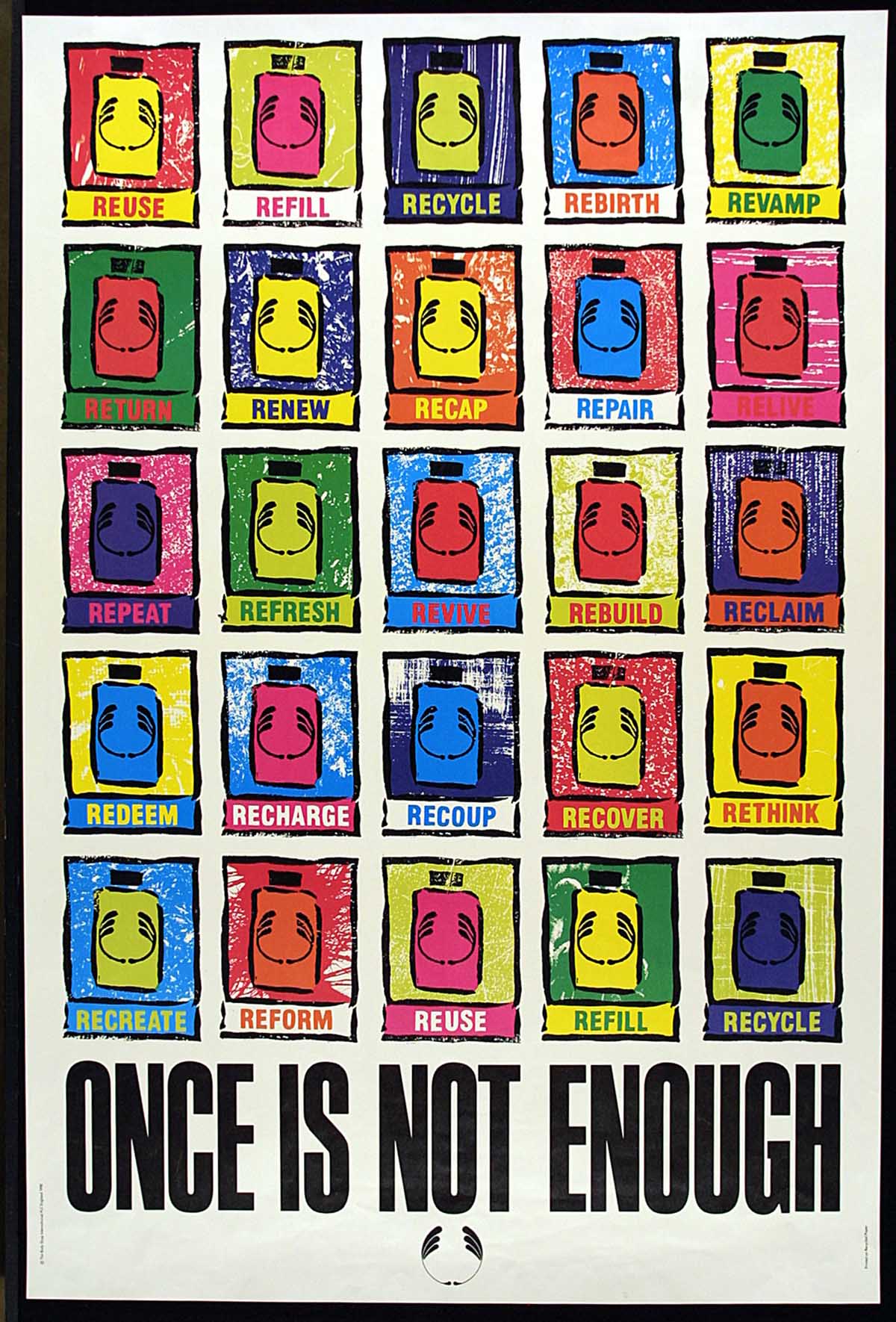
Poster, Once Is Not Enough, 1990, Richard Browning for The Body Shop in the Plasticene section of at Plastic: Remaking Our World
Plastic also played an integral role in the space race with 20 of the Apollo spacesuit fabrics made by DuPont.
The material represented new frontiers and inspired designers with its limitless possibilities, reflected in futuristic shapes and new interior design concepts.
Examples on display include Eero Aarnio’s Ball Chair (1963), Gino Sarfatti’s Moon Lamp (1969), and the Toot-a-Loop (1971), a plastic bracelet with a built-in radio.
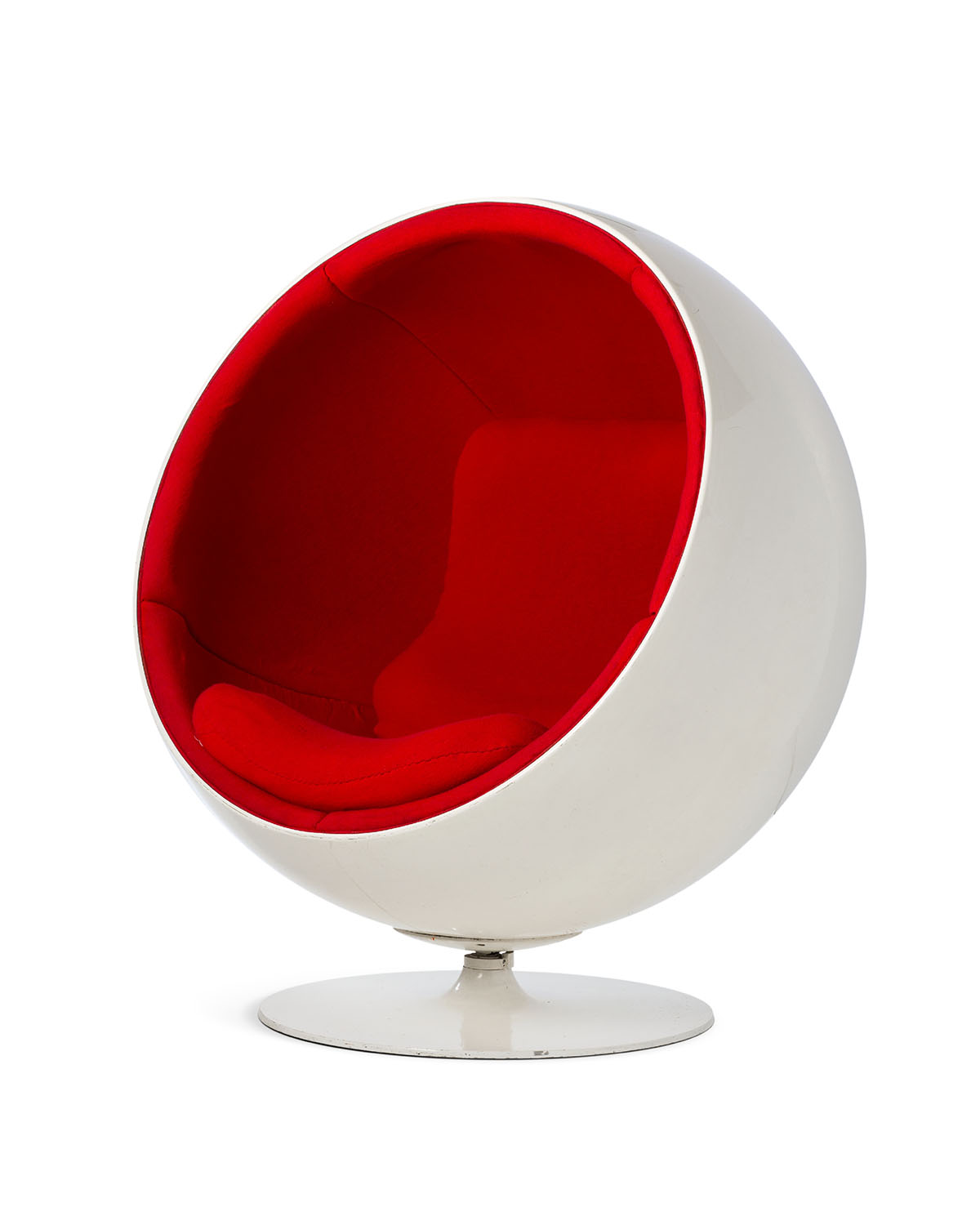
Eero Aarnio, Pallo / Ball Chair, Globe Chair, 1963
Mass production techniques ensured high demand was met at low cost, and even the oil crisis in 1973 had little long-term effect on the plastic boom.
Around this time the environmental movement emerged with the founding of "Greenpeace" in 1971 and a growing counterculture seeking self-sufficient lifestyles. Jane Atfield’s "Made from Waste" series of furniture is one of the earliest examples of recycling from the 1990’s and is included in the exhibition.
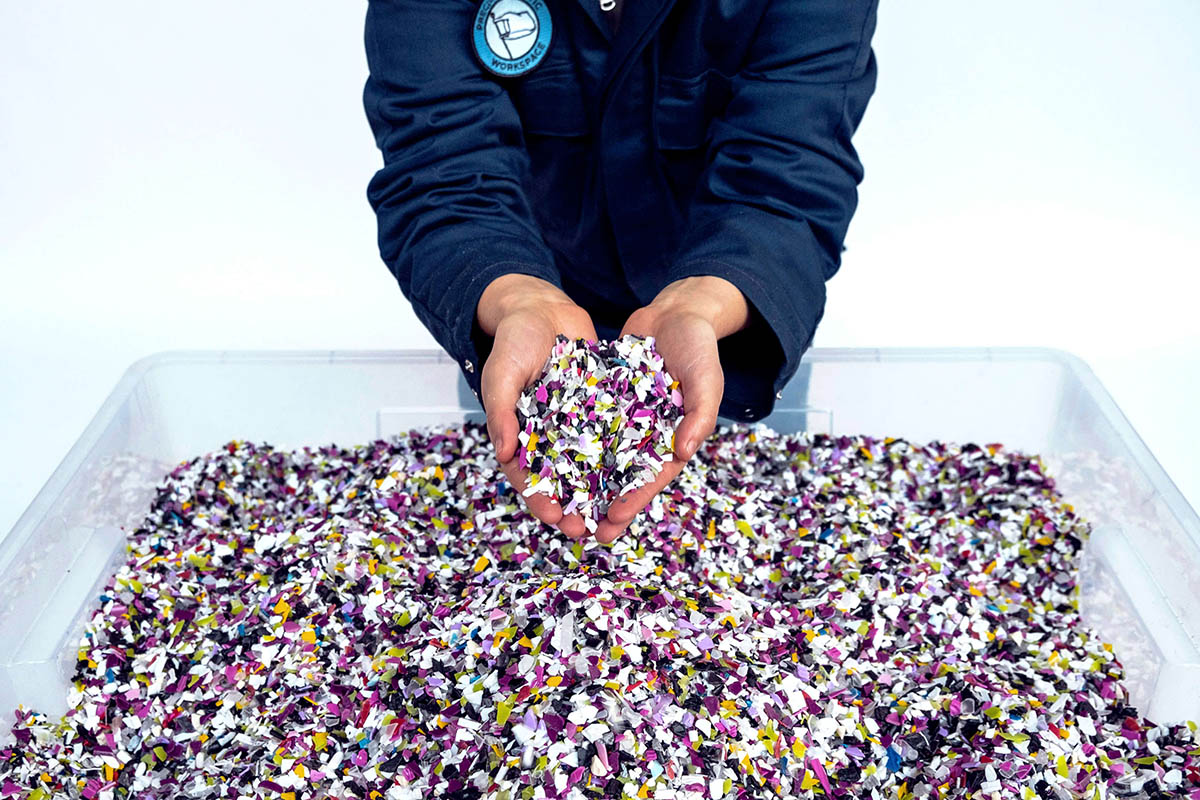
Precious Plastic, shredded plastic
Here visitors are presented with examples of “the plastic paradox”, looking at how plastic is integral to contemporary life from global trade, digital infrastructures, and international travel to humanitarian aid and healthcare.
Contributions from NHS Tayside’s Ninewells Hospital, including a life-saving incubator, show plastic’s integral role in healthcare as well as the excess of single-use plastics in this sector.
Logan Stewart, Ava Kiddie, Hannah Webster and Hamish Patterson from Claypotts Primary in Dundee at The Beach with items gathered by schools across Scotland at Plastic: Remaking Our World
Primary schools across Scotland contributed to the research required to develop "The Beach" installation.
Schools were asked to send objects of varying sizes to include in the exhibition to illustrate the different types of marine litter found across Scotland’s coastline. The most common objects received were plastic bottles and lids.
Food packaging was a recurring object as was rope, with many schools noticing the impact of the fishing industry. One object included is a Fairy Liquid bottle from the 1960s, which was found by Ladyloan Primary School in Arbroath as part of the Great Angus Beach Clean Up - a stark illustration of how long discarded plastics remain in our seas.
Featured alongside The Beach is a film featuring Claypotts Castle Primary School in Dundee, in which the children share their experiences of what was found on their local beach.
Re-section of Plastic: Remaking Our World
The third and final part of the exhibition, Re-explores contemporary approaches to rethinking the future of plastic and asks what role design can play in reducing, reusing, recycling and remaking.
Re-section at Plastic: Remaking Our World
Projects including The Ocean Clean Up, Everwave, and The Great Bubble Barrier show ways to filter plastic waste from rivers and oceans, but it also makes clear that effective reduction of plastic waste must start an earlier point. The circular approach to design takes account of an object’s life cycle.
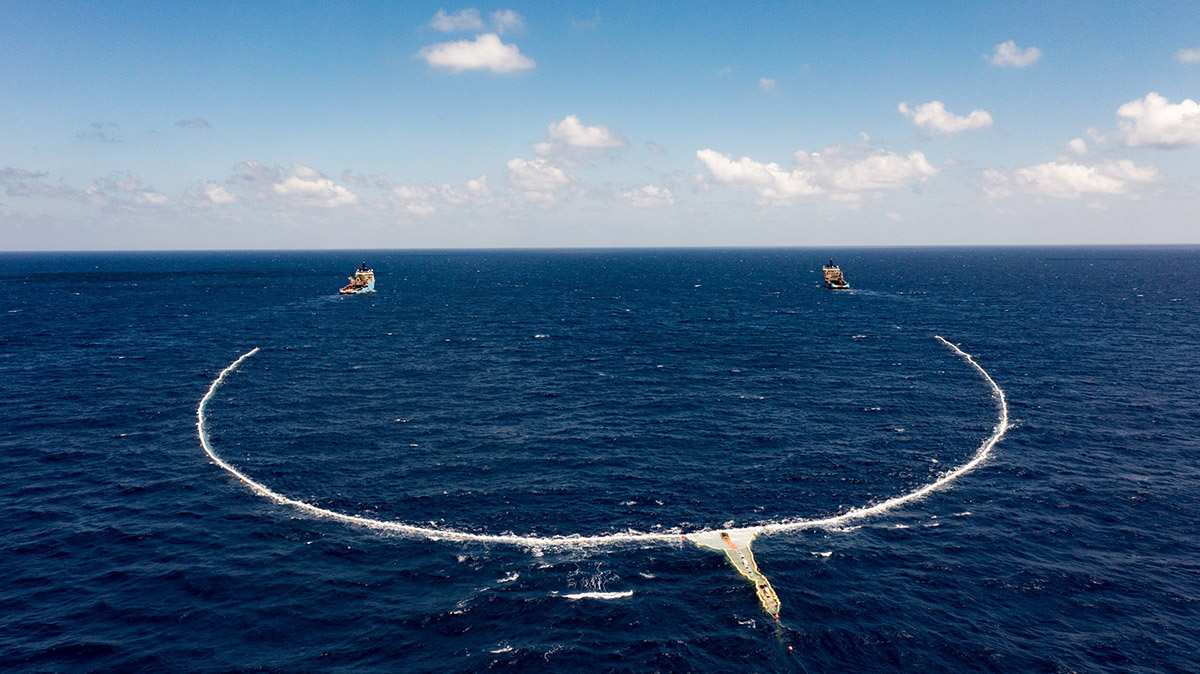
The Ocean Cleanup, system 002 deployed for testing in the Great Pacific Garbage Patch, 2021
An example is the Rex Chair (2011/2021) designed by Ineke Hans which can be returned to the manufacturer for repairs or recycling.
Free to visit for all, Plastic Lab invites visitors to explore the promise and problem of plastic and houses two Precious Plastic recycling machines, showing how plastic waste can be turned into a valuable resource.
Catherine Bozec from Zero Waste Scotland and Laura Young (Less Waste Laura) with the new commission from Sarah Rose (Open Source) crocodile 2021 at Plastic: Remaking Our World.
There is also a new artwork on display. Open Source (crocodile) 2021, suspended above the lower floor of the museum by Glasgow-based artist Sarah Rose explores the limitless properties of plastic.
Made from re-melting recycled HDPE plastic bottle lids into thin sheets and joining the scales together the modular but adaptable structure takes on the form of an abstract crocodile.
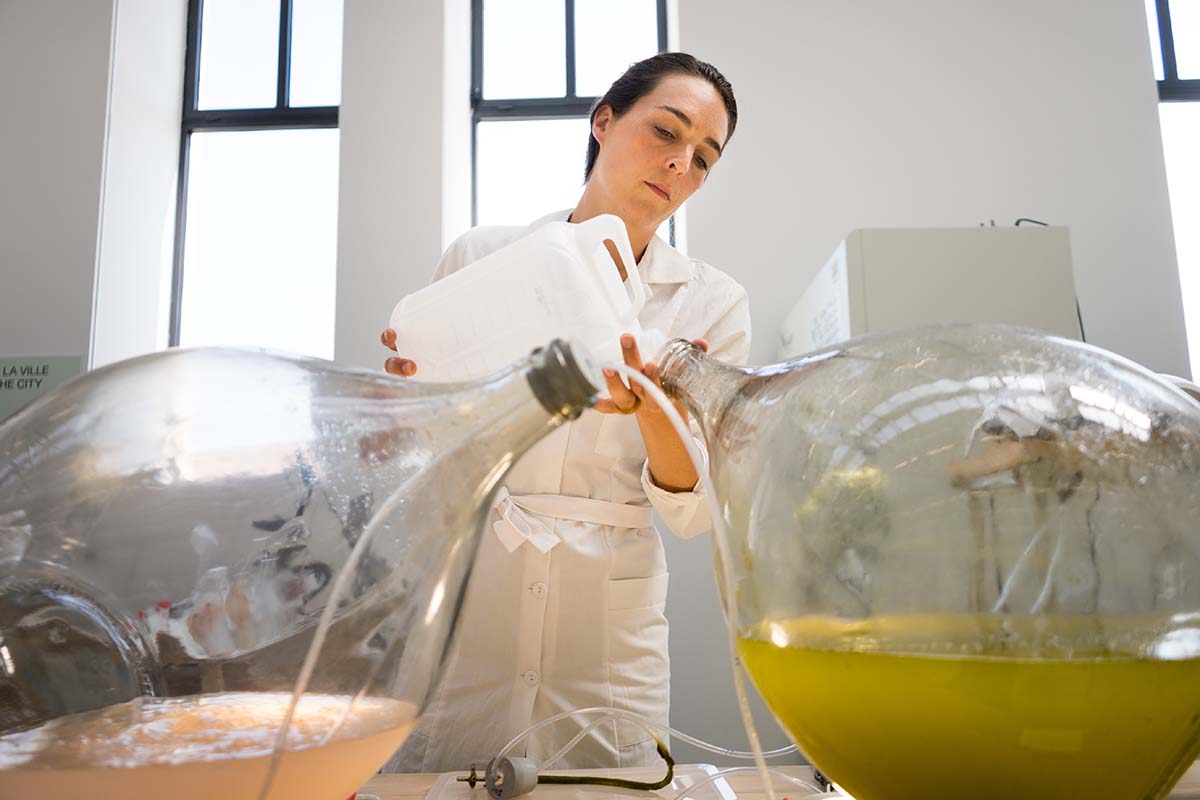
Klarenbeek & Dros in collaboration with Luma, cultivation of micro algae for biopolymers. Image © Antoine Raab, courtesy of Luma
"Looking at plastic through the lens of design allows visitors to understand more about its history and why, in a relatively short space of time, it transformed from wonder material to a problem affecting our entire planet," said Charlotte Hale, Curator at V&A Dundee.
"The exhibition shows the evolution of plastic and the changing attitudes to the material from the 1850s through to the present day, ending with a look to the future to explore the different approaches across multiple sectors, to tackling the plastic crisis," Hale added.
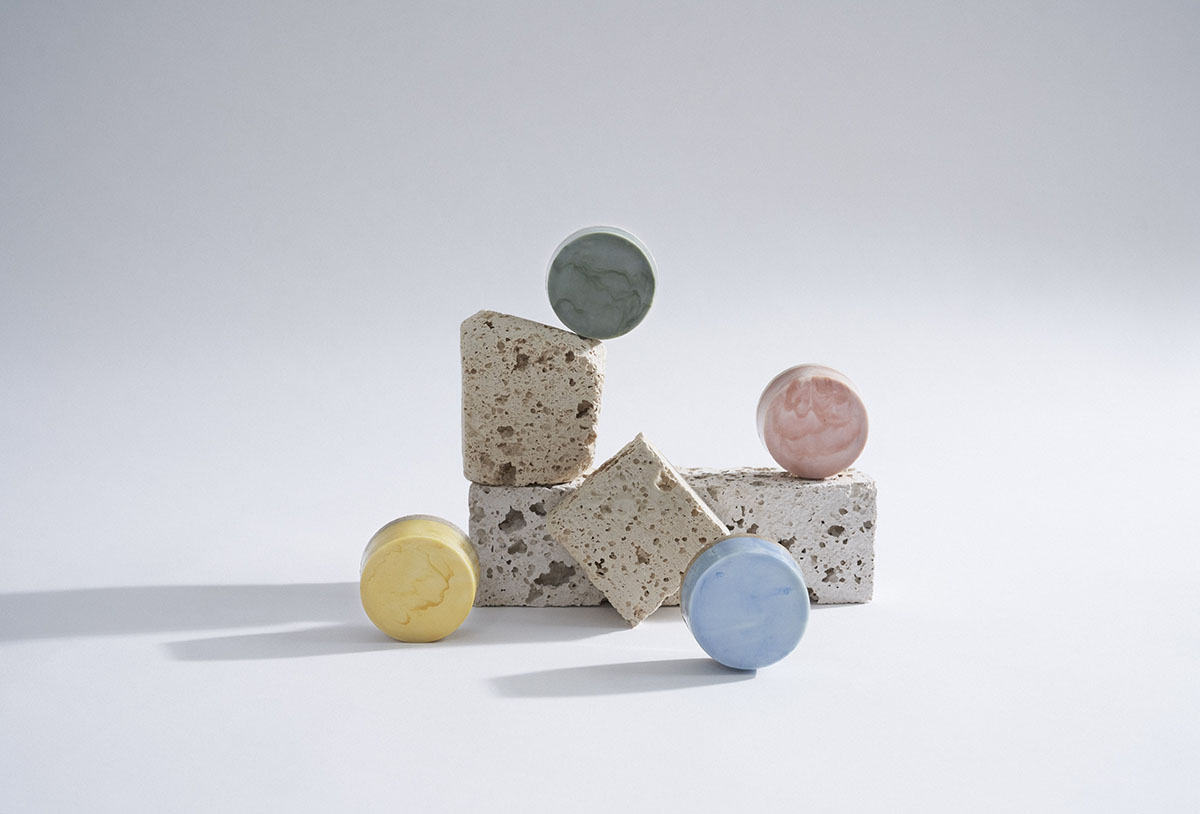
Shellworks, jars made from Vivomer, a bioplastic produced with the help of microbes, 2021. Image © Shellworks, Photo: Catharina Pavitschitz
"Plastic can be seen as one of the most successful designs of all time, shaping and saving our lives like no other material over its 150-year history. Yet, we are acutely aware of the environmental destruction and waste caused by the mass production and consumerism of plastic," said Leonie Bell, Director of V&A Dundee.
"As Scotland’s design museum we want to look at the complex design and social histories of challenges like this, to look to the future with hope in our collective creativity and innovation. We are delighted to have developed Plastic: Remaking our World in international partnership with Vitra Design Museum, Germany, MAAT Lisbon, and the V&A in London," Bell added.
Plastic: Remaking Our World Curatorial Team
V&A Dundee: Charlotte Hale, Laurie Bassam; Vitra Design Museum: Jochen Eisenbrand, Mea Hoffman; maat, Lisbon: Anniina Koivu; V&A: Johanna Agerman Ross, Corinna Gardner.
Plastic: Remaking Our World catalogue: The exhibition is accompanied by a comprehensive publication including several essays, reprints of key texts about the history of plastic, and conversations with key figures.
Top image in the article: The Beach at Plastic: Remaking Our World.
All images courtesy of V&A Dundee unless otherwise stated.
> via V&A Dundee
